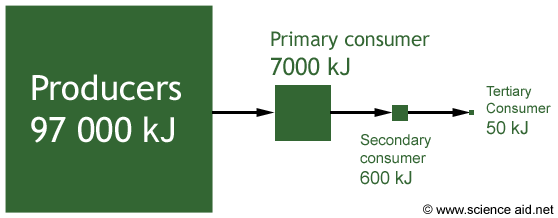The reason why not all of the energy will make it to the next tropic level is that some of it will be used up on the level it is at. The energy is used for the life processes of the animal that it is in.
e.g If a bunny rabbit eats a cabbage, it will use some of the energy to keep warm, some to move e.c.t so fox only gets some of the original energy from the cabbage.
This blog will cover and explain the specification for Edexcel triple science course 2013 for biology. Hope it helps :)
Saturday, 30 March 2013
4.6 understand the transfer of substances and of energy along a food chain
As one thing consumes another the energy and other things inside it- for example fat and vitamins- get transferred to the consumer. If you eat a fatty piece of beef you get the fat from the cow.
4.5 understand the concepts of food chains, food webs, pyramids of number, pyramids of biomass and pyramids of energy transfer
 |
| sciencebitz.com |
A food chain shows the transfer of energy up the food chain beginning with the producers then the primary consumers and so forth.
| king.portlandsschool.org |
A food web links several animals within a habitat showing what consumes what and is consumed by what.
 |
| BBC.co.uk |
 |
| BBC.co.uk |
 |
| scienceaid.net |
2.40 understand that respiration continues during the day and night, but that the net exchange of carbon dioxide and oxygen depends on the intensity of light
Respiration is a continuous process in living things, so won't stop at any time. But photosynthesis depends on light and so will stop in the dark. This means that in the night carbon dioxide will be being given out by respiration but not taken in for photosynthesis, so the net exchange of carbon has an increased out put. In the same way at night oxygen will not be being given out as there is no photosynthesis.
2.39 understand gas exchange (of carbon dioxide and oxygen) in relation to respiration and photosynthesis
In photosynthesis: 6CO2 + 6H2O > C6H12O6 + 6O2 + 6H2O
So the plant takes up carbon dioxide and gives out oxygen
In respiration: C6H12O6 + 6O2 > 6CO2 + 6H2O
So the plant gives out carbon dioxide
So the plant takes up carbon dioxide and gives out oxygen
In respiration: C6H12O6 + 6O2 > 6CO2 + 6H2O
So the plant gives out carbon dioxide
2.37 describe experiments to investigate the evolution of carbon dioxide and heat from respiring seeds or other suitable living organisms
Collect the gas coming off the seed and bubble through lime water to see if it turns cloudy. Place in a cool environment and measure the surrounding air heating up.
2.32 describe an experiment to investigate the energy content in a food sample
Hold a piece of food under a tube of water, burn the food. When it is fully burned compare the heat of the temperature before and after. The change in heat is the energy in degrees, convert if needed.
Subscribe to:
Comments (Atom)